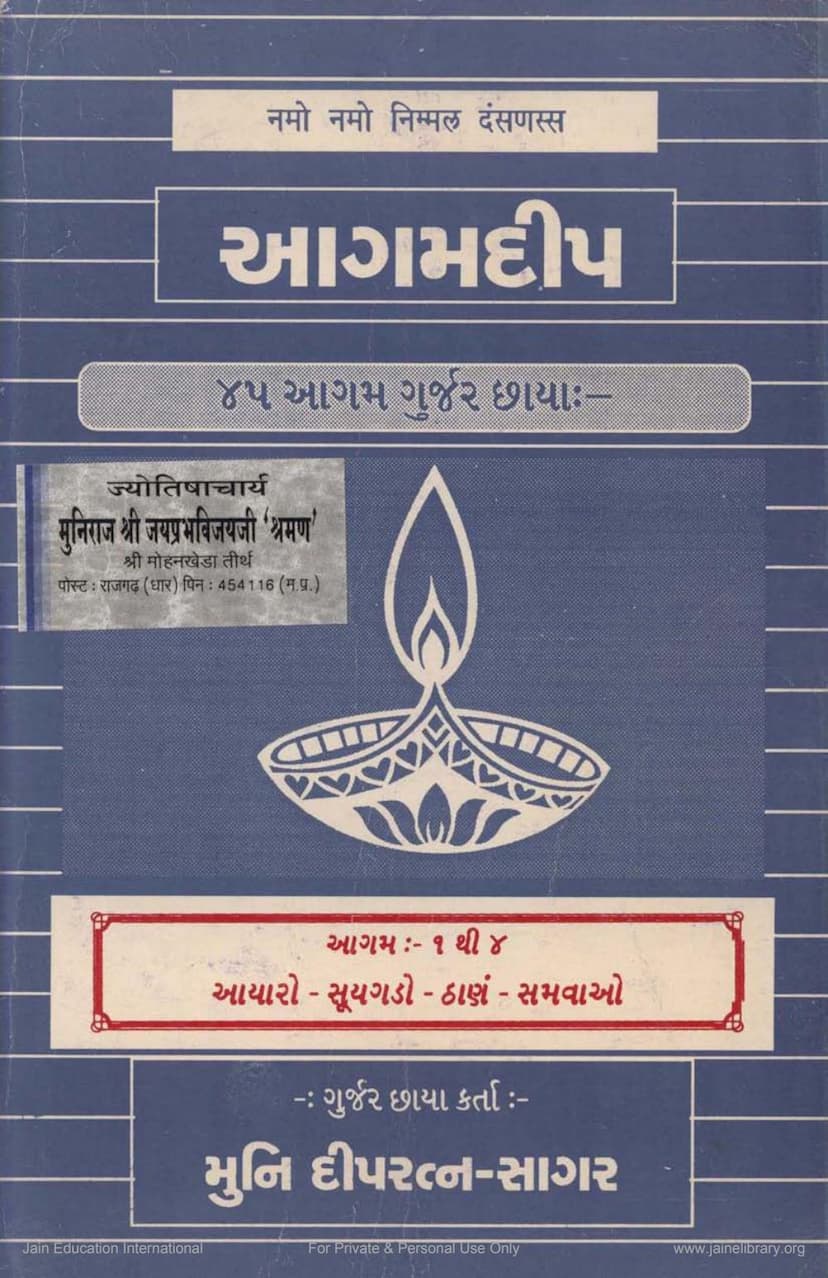Agam Deep 36 Vavahara Gujarati Anuvaad
Added to library: September 1, 2025

Summary
This document is a Gujarati translation and commentary titled "Agam Deep 36 Vavahara Gujarati Anuvaad" (Agam Deep: Gujarati Commentary on Vavahara) authored by Dipratnasagar and published by Agam Shrut Prakashan. It is part of a larger series called "Agam Deep" which aims to provide explanations of the Jain Agamas.
The catalog link provided is for the Jainology archive, specifically for "Agam Deep 36 Vavahara Gujarati Anuvaad." The author, Munishri Dippratna Sagar, is credited with creating the "Gurjar Chhaya" (Gujarati explanation).
Key aspects of the document:
- Subject Matter: The text focuses on the Vavahara Sutra, which is the third Cheda Sutra in the Jain Agamas. The Vavahara Sutra deals with the rules and regulations for the conduct of Jain monks and nuns, particularly concerning penance, atonement, and monastic discipline.
- Content Breakdown (as seen in Page 4): The table of contents indicates that the Vavahara Sutra is divided into 10 sections (Uddesh):
- Penance rituals, etc.
- Rules for monks traveling with one or more fellow monks.
- Initiation, scriptural permissions, etc.
- Rules regarding seasons for monks and nuns.
- Rules regarding alms, excess, and monastic positions.
- Statements on permissible and impermissible for monks and nuns.
- Rules regarding bedding, seating, entering, etc.
- Description of deities.
- Rules regarding food and drink.
- Descriptions of various types of fasts and vows.
- Purpose: The "Agam Deep" series, and this volume in particular, aims to make the complex Jain Agamas accessible to Gujarati-speaking readers through detailed explanations ("Gurjar Chhaya"). This implies that the original text is likely in Prakrit or Sanskrit, and the authors are providing a scholarly and interpretative rendering.
- Sponsorship and Publication: The document highlights numerous financial contributors ("Dravya Sahayak") who made the publication possible, indicating a community effort behind this work. The publisher is Agam Shrut Prakashan.
- Structure of the "Agam Deep" Series: Pages 7-10 list other publications in the "Agam Deep" series, covering various other Jain Agamas and related texts, suggesting a comprehensive effort to publish and explain the Jain scriptures.
- Specific Content of Vavahara (Pages 11-28): The provided text delves into various aspects of the Vavahara Sutra, including:
- Penance (Prayashchitta): Detailed discussions on the duration and types of penance for different transgressions by monks and nuns, including the concept of Maya (deception) influencing the penance.
- Monastic Conduct: Rules regarding interacting with other monks, seasonal observances, rules for alms-seeking, and the conduct related to living spaces, food, and possessions.
- Leadership and Hierarchy: Discussions on who can become a monastic leader (Acharya, Upadhyaya, Ganavachchhedak), the qualifications, and the procedures for appointing them.
- Disciplinary Actions: Rules regarding transgressions, the process of confession (Alochna), atonement, and the consequences of breaking monastic rules.
- Acceptable and Unacceptable Conduct: Detailed guidelines on what is permissible and impermissible for monks and nuns in various situations.
- Specific Rules for Different Groups: The text elaborates on rules for monks, nuns, and sometimes differentiates between those with different levels of seniority or scriptural knowledge.
- Practical Scenarios: The text addresses various scenarios like how to handle illness, how to interact with householders, and specific rules for accepting food or alms.
- Vows and Observances: The text touches upon different types of vows and their observance, like the "Peshaba Pratima" (urine-related observances) and the specific rules for taking alms.
- Types of Monks/Nuns and their Conduct: The text categorizes monks and nuns based on their conduct, knowledge, and seniority, outlining specific rules for each category.
In essence, "Agam Deep 36 Vavahara Gujarati Anuvaad" is a scholarly work that aims to explain and clarify the intricate rules and disciplinary measures outlined in the Jain Vavahara Sutra, making this important Agama accessible to the Gujarati-speaking Jain community. It's a comprehensive guide to monastic conduct and the framework for maintaining spiritual discipline within the Jain tradition.